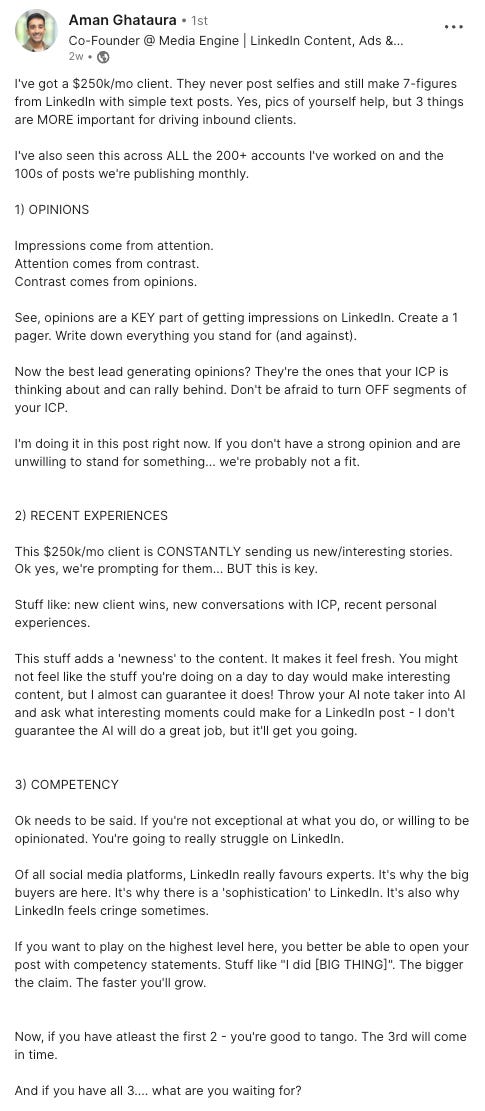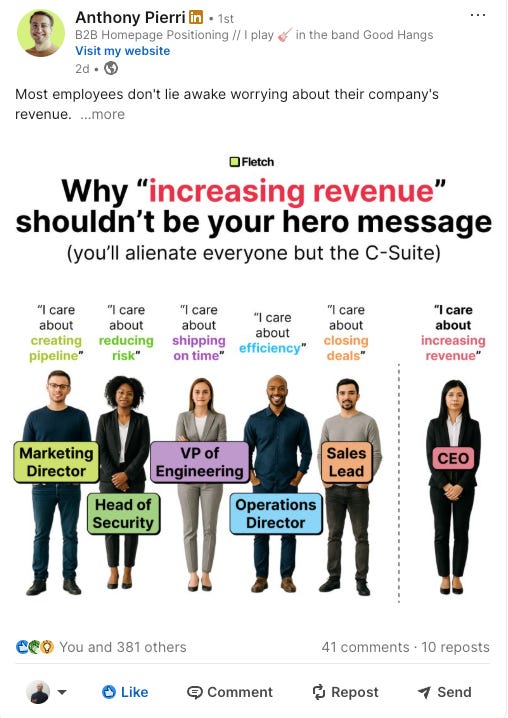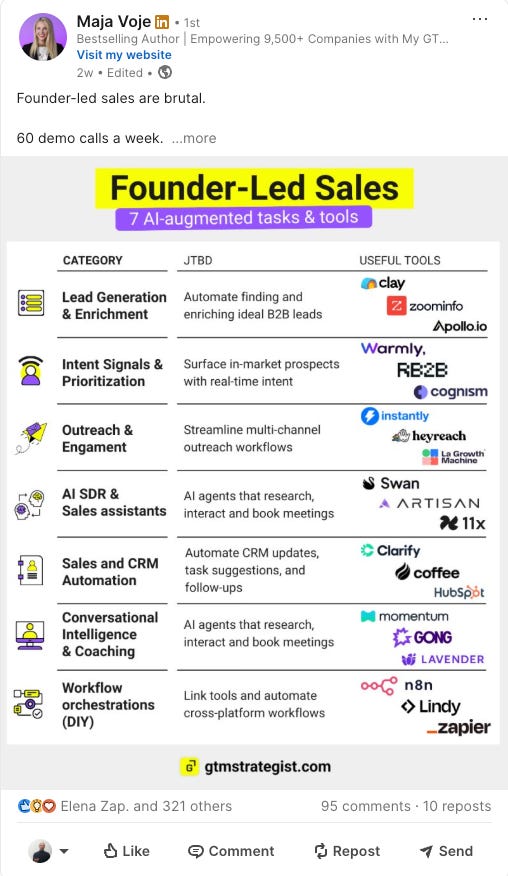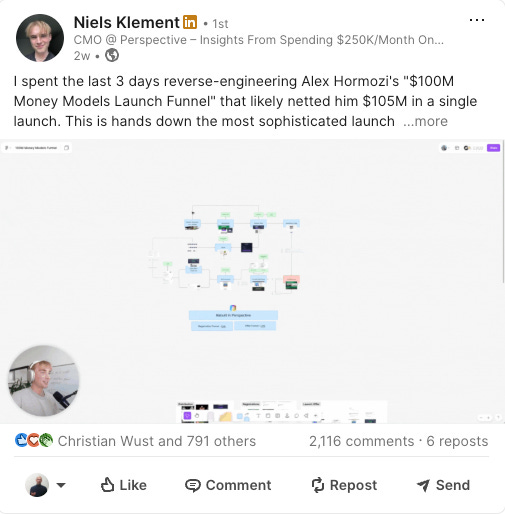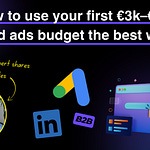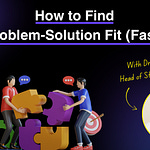I’ve talked to 50+ early-stage B2B founders over the last 8 weeks.
Most asked me the same question, when talking about LinkedIn:
Can you explain why some LinkedIn posts reach 10,000+ impressions while my stall at 500–2,000?
6 months ago, my answer would have been “no, sorry, I can’t.”
I was able to explain to them how to ‘hack’ impressions by posting ‘comment-for-x’ kinda posts, but that’s it.
(And btw, you really shouldn’t do this too often. If you do such posts, make sure to overdeliver on value. Otherwise it hurts your reputation more than you get out of it.)
But today, after investing a lot of time into LinkedIn, doing ghostwriting for my clients and exchanging with marketing & LinkedIn experts, I think I got closer to having an answer. And I’ll share it with you today.
Plus how to break through each step, or impression band.
Let’s start with what content you should post.
New here? Hey, I am Valentin.
Each week, I share practical marketing strategies, tactics and learnings designed to help you scale your B2B business to €1 million ARR and beyond 🚀
Make sure to subscribe to not miss out on any episode!
Want to become a thought leader? Do this:
When I work with clients I usually tell them that the fist step is not to write lots of post and publish them, but instead establish a framework. A systematical approach to content creation on LinkedIn. (others would call it a content strategy lol)
I use this framework (feel free to steal it):
📆 DAY 1: Broad contrarian takes or opinions / Challenge industry assumptions / Hot news to cover (with a take)
Challenge industry assumptions. "Everyone thinks you need X, but actually..." These grab attention because they make people question what they believe.
Hot news to cover (with a take)
📆 DAY 2: Specific client wins / recent experience
Real case studies with real numbers. "My client went from 200 to 20K followers doing this..." Social proof builds trust faster than any sales pitch.
📆 DAY 3: Tactical how-to content / recent experience / competency
Tools, systems, and actionable strategies. "5 XXX most professionals ignore..." This positions you as the go-to expert in your field.
Educational content is shown as a process
📆 DAY 4: Mindset and psychology / emotional connection
Address the fears holding your audience back. "Why most XXX never start/do/… XXX" Creates emotional connection.
Create posts that target a visceral pain (e.g., “Marketers, I’ll make you cry in seven words,” followed by a single punchline line).
📆 DAY 5: Personal transformation stories
Your vulnerable moments and breakthroughs. "I used to be terrified of posting on LinkedIn..." This is where followers really start to engage with your content.
Personal (founder) story to inspire others to be different.
Aman, who runs an allbound LinkedIn agency and also does ghostwriting for his clients, said this in one of his recent posts:
Some examples of thought leaders in the B2B SaaS space:
Anthony Pierri - link to post - often combining opinions with experience and competency
Maja Voi - link to post - mostly combining experience with competency
Nils Klement - link to post - mostly talking about experience
Understanding your current situation
Now that you know what content to use in general to become a thought leader and build reach and visibility, it’s time to analyse where you are, why you don’t grow and what you would need to do in order to reach the next step.
(credits to Aman who broke it down very nicely)
0-500 impressions — People don’t care yet
Problem
With new or inactive accounts, “no one gives a shit what you have to say,” especially if the content is commodity advice (e.g., “10 ways to run better ads”). Audiences don’t know or trust the poster. You’re assuming you’re famous; assume you’re not.
What to do
Add competency/status to your post: e.g., “I spend $1M/month on ads - here are 10 ways to do it better.”
Or use story/status hooks: e.g., “Yesterday I spoke to a CEO making $5M a year / a $100M CEO - here’s what he told me.” These cues make people care.
1,000–2,000 impressions — Not optimized for the platform
Observation
It’s easy to hit ~1,000 impressions with personal posts (“I did this…” - “This is what I feel when..” - “How my morning routine looks like..”), supported by your network. Beyond that, many get stuck because they’re not optimizing for LinkedIn.
What to do
Improve your copy writing! Use LinkedIn-native formatting: strong hooks, scannable paragraphs/listicles, and familiar copy patterns. This is a beginner skill you can learn by studying effective posts; if you’ve never done social copywriting, you need to adopt these patterns.
If you’re just getting started, follow some copy writers, ghostwriters and other profiles with lots of reach on LinkedIn to learn how they write hooks and how they structure their posts.
2,000–5,000 impressions — Ideas aren’t relevant enough
Problem
Even with platform-optimized writing and some credibility, posts stall if the idea doesn’t hit real emotional triggers or inner desires/pains.
Signals & examples
Posts that target a visceral pain (e.g., “Marketers, I’ll make you cry in seven words,” followed by a single punchline line) tend to perform.
Example: A post about a client getting lots of booked calls without gaming the algorithm, using hacks, images, or selfies resonated because many don’t want to post selfies. These speak to what people feel but don’t say aloud.
Takeaway
Watch posts that reach 2k–5k closely. Something in the hook/body made people feel something. That’s the first point where you’re truly impacting how they think/feel and start to connect with them.
5,000–10,000 impressions — Ideas aren’t broad enough
Problem
At this level, reach correlates with breadth. Narrow targeting caps distribution.
Examples
A post aimed at “$10M CMOs in B2B SaaS” only fits those near that number; one aimed at “$500M businesses’ CMOs” is even narrower, especially if the body is very tactical. Fewer people find it relevant, so impressions don’t climb.
What to do
Make the idea widely relevant so more of the feed can engage, pushing LinkedIn to distribute further.
Easy path: ride trends - e.g., the recent GPT-5 wave, or discussion that PayPal is hiring a head of CEO content/a ghostwriter. Many can form an opinion on broad, timely topics, so impressions rise.
10,000+ impressions — Clarity limits virality
Problem
Even broad ideas stall short of “stupidly viral” if they’re not stupidly clear and simple to read.
What to do
Strip to the core emotion or core story.
Remove fluff/nuance, make it broader/more generic, and simplify the read. That’s when impressions “go off.”
How to use the ladder
Identify your current impression range, diagnose the one bottleneck typical of that level, fix it, and post again next week/the week after.
Over time you feel more in control of the algorithm. While posts don’t always follow this exact order, the pattern is generally true across accounts the speaker works on. Some accounts now have good control for certain posts.
Let me know your thoughts about this.
And if you manage to climb up the ladder, feel free to share it with me 🫶
Cheers
Valentin
Want to learn more about B2B Growth?
Subscribe to the newsletter and follow me on LinkedIn.



